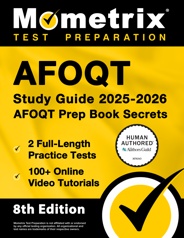Welcome to the AFOQT practice test page!
Click the “Start Test” button above to begin your free AFOQT practice test! These practice questions will give you a better idea of what to study for your exam.
What is the AFOQT?
The AFOQT (Air Force Officer Qualifying Test) is aimed specifically at individuals seeking entry into the United States Air Force. The Air Force has designated the AFOQT as a required step for incoming officers to prove they have gained the necessary skills and knowledge to fulfill their duties properly. No potential recruit can become an Air Force officer without first taking and passing this exam. After doing so, the recruit can be selected to undergo initial training procedures.
AFOQT vs. ASVAB
The AFOQT and the ASVAB are somewhat similar tests, but there are some important differences. The AFOQT, which contains more subtests and more questions than the ASVAB, is specifically for those wishing to enlist in the Airforce, while the ASVAB is for those who want to enlist anywhere in the Armed Forces. The AFOQT is also aimed toward college students, while the ASVAB is intended for high-school students.
Exam Outline
The AFOQT exam is composed of 516 multiple-choice questions. The exam lasts about five hours including breaks, with 3 hours and 23 minutes to answer questions. Each section of the exam is timed, and the time limit for each section varies.
The AFOQT features 12 subtests in all. Each subtest caters to one of the skills an entry-level Air Force officer will need to utilize throughout their training as well as within the professional environment.
This subtest simply gauges your personality. Questions on this subtest are not graded.
Verbal Analogies (25 questions, 8 minutes)
This subtest is meant to evaluate your ability to identify how words can be used to establish assertions or illustrate certain principles (such as time or comparisons).
Arithmetic Reasoning (25 questions, 29 minutes)
This subtest assesses your ability to solve word problems. You will have to rely on your knowledge of geometry, proportions, ratios, mixtures, integers, percentages, and time-distance.
Word Knowledge (25 questions, 5 minutes)
This subtest focuses on your capability to define and understand the words used within written language. Questions featured on the subtest will generally offer a word, then ask you to find a synonymous word within the answer choices.
Math Knowledge (25 questions, 22 minutes)
This subtest centers on the basics of mathematics, including algebra, geometry, and arithmetic. To solve the questions contained on this subtest, you must answer algebra-based word problems, as well as comprehend inequalities, algebraic expressions, equations systems, absolute values, and exponents.
Reading Comprehension (25 questions, 24 minutes)
This subtest measures your ability to read a passage and understand its meaning, including the implied meaning.
Situational Judgment (16 questions, 35 minutes)
This subtest measures your ability to respond to interpersonal issues and serve as a leader.
Physical Science (20 questions, 10 minutes)
This subtest assesses your knowledge of high-school-level physical science concepts. You can expect to see questions relating to force relationships, physical laws, and simple machines.
Aviation Information (20 questions, 8 minutes)
This subtest concentrates on your comprehension of flight mechanics and aviation concepts. You must demonstrate your knowledge of rotary aircraft, the attributes of rudimentary aviation, aircraft with fixed wings, the security regulations enforced by modern US airports, and flight physics.
Instrument Comprehension (25 questions, 5 minutes)
This subtest deals with your comprehension of how to calculate where an airplane is in the sky through the use of altitude indicators and magnetic compasses.
Table Reading (40 questions, 7 minutes)
This subtest evaluates how well you can interpret a simple \(x\)–\(y\)-axis graph.
Block Counting (30 questions, 5 minutes)
This subtest addresses how well you understand the concept of spatial awareness. Questions under this category will present a group of blocks (rendered in 3D) and request that you count the number of blocks surrounding one individual block.
Check Out Mometrix's AFOQT Printed Study Guide
Get practice questions, video tutorials, and detailed study lessons
Get Your Study Guide
Registration
If you are interested in sitting for the AFOQT, you must first reach out directly to a recruiter, who will look into your background to check for eligibility. Once you are verified, you can work out a date for the exam with the recruiter. The test is free of charge, but you will only receive two opportunities total to sit for the exam.
In order to register for the AFOQT, you must also have a good financial history, possess no criminal record, be between ages 18 to 34, have obtained your Bachelor’s degree at minimum, and be a citizen of the United States.
Test Day
When you show up to take your test, be prepared to be in the testing facility for approximately around five hours. Every question is written in multiple-choice format with four or five answer choices. There is no penalty for choosing the incorrect answer. Each section of the test is timed, so it is best to be prepared and to work quickly.
How is the AFOQT Scored?
While there are 12 subtests, you can expect to only receive five total scores for the full AFOQT exam. This is because each subtest will be grouped into five specific categories. Instead of a numeric score, you will be informed of where you fall within a percentile, which ranges between 0 and 99.
The AFOQT score categories (and the subtests that fall under each category) include:
- Quantitative (Math Knowledge, Arithmetic Reasoning)
- Pilot (Aviation Information, Table Reading, Instrument Comprehension, Math Knowledge)
- Verbal (Word Knowledge, Verbal Analogies, Reading Comprehension)
- Combat Systems Officer (Word Knowledge, Math Knowledge, Table Reading, Block Counting)
- Air Battle Manager (Verbal Analogies, Math Knowledge, Table Reading, Instrument Comprehension, Block Counting, Aviation Information)
The minimum percentile you must earn depends on the type of career you want to attain while serving as an Air Force officer. Those who want to become a pilot, combat systems officer (CSO), or air battle manager (ABM) must earn a combined score of at least 50 points.
Here are the required score breakdowns for each role:
Pilot:
- Verbal: 15
- Quantitative: 10
- Pilot: 25
- CSO: 10
- ABM: N/A
Combat System Officer:
- Verbal: 15
- Quantitative: 10
- Pilot: 10
- CSO: 25
- ABM: N/A
Air Battle Manager:
- Verbal: 15
- Quantitative: 10
- Pilot: N/A
- CSO: N/A
- ABM: 25
General Commissioning:
- Verbal: 15
- Quantitative: 10
- Pilot: N/A
- CSO: N/A
- ABM: N/A
Scores do not represent an actual numeric value but instead signify how well you performed in relation to others who have taken the exam. A score of 50 represents the exact middle of the percentile and is considered to be the “average.” Your scores will remain valid for the remainder of your lifetime.
You may re-apply to take the exam but only after a minimum of 180 days has passed from the first test date.

AFOQT Online Prep Course
If you want to be fully prepared, Mometrix offers an online AFOQT prep course designed to give you everything you need to succeed!
Here’s what you’ll find in the AFOQT course:
- 30+ Review Lessons Covering Every Topic
- Over 1,900 AFOQT Practice Questions
- 120+ Video Tutorials
- 300+ Digital Flashcards
- Money-back Guarantee
- Mobile Access
Everyone learns differently, so we’ve tailored the AFOQT online prep course to ensure every learner has what they need to prepare for the AFOQT exam.
Click below to check it out!
Study Tips
How to Study Effectively
Your success on AFOQT test day depends not only on how many hours you put into preparing but also on whether you prepared the right way. It’s good to check along the way to see whether your studying is paying off. One of the most effective ways to do this is by taking AFOQT practice tests to evaluate your progress. Practice tests are useful because they show exactly where you need to improve. Every time you take a free AFOQT exam practice test, pay special attention to these three groups of questions:
- The questions you got wrong
- The ones you had to guess on, even if you guessed right
- The ones you found difficult or slow to work through
This will show you exactly what your weak areas are and where you need to devote more study time. Ask yourself why each of these questions gave you trouble. Was it because you didn’t understand the material? Was it because you didn’t remember the vocabulary? Do you need more repetitions on this type of question to build speed and confidence? Dig into those questions and figure out how you can strengthen your weak areas as you go back to review the material.
Answer Explanations
Additionally, many AFOQT practice tests have a section explaining the answer choices. It can be tempting to read the explanation and think that you now have a good understanding of the concept. However, an explanation likely only covers part of the question’s broader context. Even if the explanation makes sense, go back and investigate every concept related to the question until you’re positive you have a thorough understanding.
Comprehend Each Topic
As you go along, keep in mind that the AFOQT practice test is just that: practice. Memorizing these questions and answers will not be very helpful on the actual test because it is unlikely to have any of the same exact questions. If you only know the right answers to the sample questions, you won’t be prepared for the real thing. Study the concepts until you understand them fully, and then you’ll be able to answer any question that shows up on the test.
Strategy for AFOQT Practice
When you’re ready to start taking practice tests, follow this strategy:
- Remove Limitations. Take the first test with no time constraints and with your notes and AFOQT study guide handy. Take your time and focus on applying the strategies you’ve learned.
- Time Yourself. Take the second practice test “open book” as well, but set a timer and practice pacing yourself to finish in time.
- Simulate Test Day. Take any other practice tests as if it were test day. Set a timer and put away your study materials. Sit at a table or desk in a quiet room, imagine yourself at the testing center, and answer questions as quickly and accurately as possible.
- Keep Practicing. Keep taking practice tests on a regular basis until you run out of practice tests or it’s time for the actual test. Your mind will be ready for the schedule and stress of test day, and you’ll be able to focus on recalling the material you’ve learned.
FAQs
Q
How many times can you take the AFOQT?
A
The Air Force limits your testing attempts to two. If you do take the test a second time, your second results will take the place of your first attempt, even if your first attempt scored better. You won’t be able to attempt the test a second time until at least 180 days have passed. Under very rare circumstances, a waiver can be issued to allow extra attempts.
Q
How many questions are on the AFOQT?
A
There are a total of 516 questions on the exam.
Q
How long is the AFOQT?
A
The time limit for the exam as a whole is 3 hours and 23 minutes.
Q
Can you use a calculator on the AFOQT?
A
No, you may not use a calculator on this exam.
Q
What are good AFOQT scores?
A
The score you need depends on which career path you choose.
Affiliate disclosure: As an Amazon Associate, we may earn commissions from qualifying purchases from Amazon.com.


